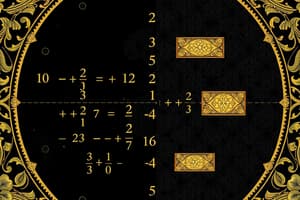Podcast
Questions and Answers
Which equation correctly represents the phrase 'Three times a number is 15'?
Which equation correctly represents the phrase 'Three times a number is 15'?
- 3 - x = 15
- 3 + x = 15
- x / 3 = 15
- 3x = 15 (correct)
What is the first step to solve the equation 3x = 15?
What is the first step to solve the equation 3x = 15?
- Add 3 to both sides
- Divide both sides by 3 (correct)
- Multiply both sides by 3
- Subtract 3 from both sides
If you have the equation x/4 = 3, what is the value of x?
If you have the equation x/4 = 3, what is the value of x?
- 9
- 6
- 4
- 12 (correct)
In the equation 2x/3 = 6, what should be the first operation performed to isolate x?
In the equation 2x/3 = 6, what should be the first operation performed to isolate x?
What is the correct order of operations when solving a complex equation involving both multiplication and division?
What is the correct order of operations when solving a complex equation involving both multiplication and division?
Study Notes
Multiplication and Division Symbols in Math: Application in Equations
-
Multiplication Symbol
- Represented by: × or *
- Used to indicate repeated addition of a number.
- Example: 4 × 3 means adding 4 three times (4 + 4 + 4 = 12).
- In algebra, can be implied (e.g., 2x means 2 multiplied by x).
-
Division Symbol
- Represented by: ÷ or /
- Indicates the operation of distributing a quantity into equal parts.
- Example: 12 ÷ 4 means splitting 12 into 4 equal parts (3 each).
- Can also be expressed as a fraction (e.g., 12/4).
Application in Equations
-
Setting Up Equations
- Use multiplication and division symbols to form equations based on word problems.
- Example: "Three times a number is 15" translates to 3x = 15.
-
Solving for Unknowns
- Multiplication: To isolate a variable, divide both sides by the coefficient.
- Example: From 3x = 15, divide by 3: x = 15/3 → x = 5.
- Division: To isolate a variable, multiply both sides by the divisor.
- Example: From x/4 = 3, multiply by 4: x = 3 × 4 → x = 12.
- Multiplication: To isolate a variable, divide both sides by the coefficient.
-
Order of Operations
- Remember PEMDAS/BODMAS (Parentheses/Brackets, Exponents/Orders, Multiplication and Division, Addition and Subtraction).
- Perform multiplication and division from left to right before addition and subtraction.
-
Combining Operations
- Equations may include both multiplication and division.
- Example: 2x/3 = 6; multiply both sides by 3 to get 2x = 18, then divide by 2 to find x = 9.
-
Real-World Applications
- Useful in calculating rates, such as speed (distance/time) or unit prices (total cost/quantity).
- Applied in financial calculations, like interest rates (principal × rate).
-
Common Mistakes
- Confusing the symbols; ensure clarity when interpreting multiplication and division.
- Misapplying the order of operations, leading to incorrect results.
Multiplication Symbol
- Represented by the symbols × or *.
- Indicates repeated addition; for example, 4 × 3 is equivalent to 4 + 4 + 4 = 12.
- In algebra, multiplication can be implied, as seen in expressions like 2x (where 2 is multiplied by x).
Division Symbol
- Represented by ÷ or /.
- Indicates distributing a quantity into equal parts; for instance, 12 ÷ 4 results in 3, as it splits 12 into four equal segments.
- Can also be expressed in fraction form, e.g., 12/4.
Application in Equations
-
Setting Up Equations: Multiplication and division symbols help translate word problems into mathematical equations. For example, "Three times a number is 15" becomes 3x = 15.
-
Solving for Unknowns:
- Multiplication: To isolate a variable, divide both sides by the coefficient. From 3x = 15, dividing by 3 yields x = 5.
- Division: To isolate a variable, multiply both sides by the divisor. For x/4 = 3, multiplying by 4 gives x = 12.
-
Order of Operations:
- Follow PEMDAS/BODMAS rules to determine the sequence of operations.
- Perform multiplication and division before addition and subtraction, moving left to right across the equation.
-
Combining Operations:
- Equations may have both multiplication and division. For example, with 2x/3 = 6, multiplying both sides by 3 results in 2x = 18, then dividing by 2 gives x = 9.
Real-World Applications
- Essential for calculating rates such as speed (distance/time) or unit prices (total cost/quantity).
- Plays a critical role in financial calculations, including interest rates, where principal is multiplied by the rate.
Common Mistakes
- Confusing multiplication and division symbols; clarity in interpretation is crucial.
- Misapplying the order of operations, which can lead to incorrect results.
Studying That Suits You
Use AI to generate personalized quizzes and flashcards to suit your learning preferences.
Description
Explore the application of multiplication and division symbols in mathematical equations. This quiz covers how these symbols are used in arithmetic operations and their role in solving equations. Test your knowledge with examples and problem-solving techniques.




